Burying the Hatchet ceremony (Nova Scotia)
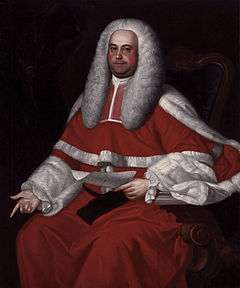
The Burying the Hatchet Ceremony (also known as the Governor's Farm Ceremony) happened in Nova Scotia on June 25, 1761 and was one of many such ceremonies where the Halifax Treaties were signed that successfully ended a period of protracted warfare, which had lasted over seventy-five years and encompassed six wars, between the Mi'kmaq people and the British (See the four French and Indian Wars, Father Rale's War and Father Le Loutre’s War). The Burying the Hatchet Ceremonies were the culmination of a negotiated treaty that created an enduring peace and a commitment to obey the rule of law.
Despite the intentions of the British dignitaries who attended the ceremony and helped draft the treaty, many of the Treaty commitments were ignored by local settlers who migrated onto Mi’kmaq and Maliseet territories. Fifteen years after the ceremony, some warfare returned as Maliseet and Mikmaq communities joined Americans against the British in the American Revolution.
Since the treaties were enshrined into the Canadian Constitution in 1982, there have been numerous judicial decisions that have upheld these treaties in the Canadian Supreme Court, the most recognized being the Donald Marshall case. Nova Scotians celebrate the Treaties of 1760-61 every year on Treaty Day (October 1).
Historical context
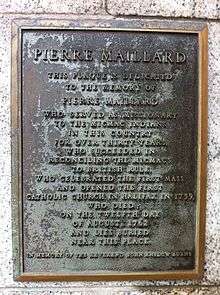
| Military history of Mi’kmaq people | ||||||||||||||||||||||||||||||||||||||||||||||||||||||||||||||||
|---|---|---|---|---|---|---|---|---|---|---|---|---|---|---|---|---|---|---|---|---|---|---|---|---|---|---|---|---|---|---|---|---|---|---|---|---|---|---|---|---|---|---|---|---|---|---|---|---|---|---|---|---|---|---|---|---|---|---|---|---|---|---|---|---|
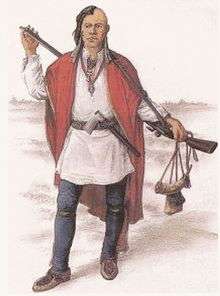 Mi’kmaq Warrior | ||||||||||||||||||||||||||||||||||||||||||||||||||||||||||||||||
| Events | ||||||||||||||||||||||||||||||||||||||||||||||||||||||||||||||||
|
||||||||||||||||||||||||||||||||||||||||||||||||||||||||||||||||
| Other | ||||||||||||||||||||||||||||||||||||||||||||||||||||||||||||||||
|
| ||||||||||||||||||||||||||||||||||||||||||||||||||||||||||||||||
The northeastern region of North America, encompassing New England and Acadia/Mi'kma'ki, increasingly became an area of conflict between the expanding French and British Empires. Expansion by both Empires, over a seventy-five-year period, through six wars brought the Mi’kmaq and Acadians into conflict with British New Englanders.
Frontier warfare against families was the Wabanaki Confederacy and New England approach to warfare since King William's War began in 1688.[1] Over this seventy-five years, there was a long history of the Wabanaki Confederacy (which included the Mi'kmaq) killing British civilians along the New England/ Acadia border in Maine (See the Northeast Coast Campaigns 1688, 1703, 1723, 1724, 1745, 1746, 1747).
In an effort to prevent these French and Wabanaki massacres of British subjects, many Massachusetts Governors, issued a bounty for the scalps of men, women, and children of the Wabanaki Confederacy.[2] During Father Le Loutre’s War, Edward Cornwallis followed New England's example when, after the Raid on Dartmouth (1749), he attempted to protect the first British settlers in Nova Scotia from being scalped by putting a bounty on the Mi'kmaq (1749).
During the final period of this conflict, the French and Indian War, French Officers, Mi’kmaq and Acadians carried out military strikes against the British, particularly after the deportation of the Acadians and the bounty proclamation of 1756. The Mi'kmaq and their French allies conducted the Northeastern Coast Campaign (1755) in Maine and extended this campaign into Nova Scotia, attacking civilians during the raids on Lunenburg. Following the British capture of Louisbourg in 1758, Quebec in 1759, and Montreal in 1760, French imperial power was destroyed in North America. With the loss of their French ally the Mi’kmaq recognized the need for a new relationship with the British.
There were various treaties signed with other tribes of the Mi'kmaq and Maliseet before the formal burying the hatchet ceremony. On 11 February 1760, two tribes of the Passamaquoddy and Saint John River came to Halifax with Colonel Arbuthnot and appeared before council, renewing the treaty of 1725, giving hostages or their good behavior. Truck houses for trade were established at Fort Frederick. Two days later, on Feb 13, a treaty was ratified with Roger Morris and one of the Mi'kmaq chiefs.[3] The following month, 10 March 1760. Three Mi’kmaq chiefs Paul Laret, (LaHave); Michael Austine (Richibucto); Calude Renie (Cheboudie and Musquodoboit) made a treaty.[4] The treaties continued even after the formal ceremony: on 15 October 1761, Jannesvil Peitougashwas (Pictock and Malogomish) made a treaty.[4]
Former ally of Father Le Loutre, French priest Pierre Maillard accepted an invitation from Nova Scotia Governor Charles Lawrence to travel to Halifax and assist in negotiating with the Mi'kmaq peoples. He became a British official ("Government Agent to the Indians", with an annual salary of £150). He asked for (and received) permission to maintain an oratory at a Halifax battery, where he held Catholic services for Acadians and Mi'kmaqs in the area.[5] In his official capacity Maillard was able to obtain agreement from most of the tribal chiefs to sign peace treaties with the British in Halifax.[6]
The Ceremony
On June 25, 1761,[7] a “Burying of the Hatchet Ceremony” was held at Governor Jonathan Belcher’s garden on present-day Spring Garden, Halifax in front of the Court House.
Representing the colony were Belcher and four members of the Nova Scotia Council: Richard Bulkeley, John Collier,[8] Joseph Gerrish,[9] and Alexander Grant.[10] Also present were Admiral Lord Colville, commander-in-chief of British naval forces in North America, Major-General John Henry Bastide, the chief engineer in Nova Scotia and Colonel William Forster, the commander of Nova Scotia’s army regiments. These three men were accompanied by a detachment of soldiers.[11]
There were at least four Mi’kmaq chiefs that signed the treaty: Jeannot Peguidalonet (representing Cape Breton), Claude Atouach (Shediac), Joseph Sabecholouet (Miramichi), and Aikon Ashabuc (Pokemouche). Representatives from other villages were also present at the treaty signing.[11]
The occasion was one of “great pomp and ceremony". The two parties faced each other near a British flag. French priest Pierre Maillard was in the middle acting as the interpreter. Belcher promised the crown would protect the Mi'kmaq from unscrupulous traders, protect their religion and not interfere with Catholic missionaries living among them. Belcher gave presents to each chief along with medals that were passed down through generations as testimony to the words that bound their people to uphold the peace. Both Belcher and the chiefs then moved to the flag post, where Belcher and the chiefs formally buried the hatchet.[11]
One of the Mi'kmaq Chiefs declared that “he now buried the hatchet on behalf of himself and his whole tribe, a token of their submission and of their having made peace."[12] The Chief of the Cape Breton Mi'kmaq’s declared: “As long as the Sun and the Moon shall endure, as long as the Earth on which I dwell shall exist in the same State as you this day, with the Laws of your Government, faithful and obedient to the Crown”.[13]
At the same time the hatchet was being buried, the Chiefs went through the ceremony of washing the paint from their bodies in token of hostilities being ended. The whole ceremony was concluded by all present drinking to the king’s health. The cornerstone of the Halifax Provincial Court (Spring Garden Road) now stands beside the spot of the burial, a symbol of peace and the rule of law.[14]
Aftermath
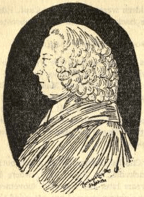
Part of a series on the |
|---|
| History of Halifax, Nova Scotia |
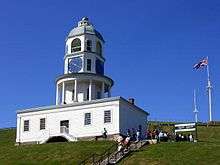 |
|
History
|
|
Events
|
|
| Part of a series on the | ||||||||||||||||||||||||||||||||||||||||||||||||||||||||||||||||||
| History of Nova Scotia | ||||||||||||||||||||||||||||||||||||||||||||||||||||||||||||||||||
|---|---|---|---|---|---|---|---|---|---|---|---|---|---|---|---|---|---|---|---|---|---|---|---|---|---|---|---|---|---|---|---|---|---|---|---|---|---|---|---|---|---|---|---|---|---|---|---|---|---|---|---|---|---|---|---|---|---|---|---|---|---|---|---|---|---|---|
.jpg) | ||||||||||||||||||||||||||||||||||||||||||||||||||||||||||||||||||
| Events | ||||||||||||||||||||||||||||||||||||||||||||||||||||||||||||||||||
|
||||||||||||||||||||||||||||||||||||||||||||||||||||||||||||||||||
| Other | ||||||||||||||||||||||||||||||||||||||||||||||||||||||||||||||||||
| ||||||||||||||||||||||||||||||||||||||||||||||||||||||||||||||||||
The British were relieved that a peace was reached. The vicar at St. Paul's Church, Thomas Wood, praised Father Maillard for his efforts in negotiating it when he wrote, “Thanks to [Maillard] many Englishmen were saved from being massacred.”[16] The Mi’kmaq retained a strong sense of themselves as a separate people. They still had their own language, a distinct material culture, trial institutions, and a spiritual life informed by Mi’kmaq tradition and an ongoing attachment to the Catholic Church, despite British attempts to converted them to Protestantism in the 1750s.[17] The disrespect they often received from British colonists only served to emphasize their status as a separate nation.
According to historian John G. Reid, the treaties of 1760-61, while they contain statement of Mi'kmaw submission to the British crown, what is known of the surrounding discussions, combined with the strong evidence of later Mi'kmaw statements, indicates that a friendly and reciprocal relationship was the real intent. The Mi'kmaw leaders who came initially to Halifax in 1760 had clear goals that centred on the making of peace, the establishment of a secure and well-regulated trade in commodities such as furs, and an ongoing friendship with the British crown. In return, they offered their own friendship and a tolerance of limited British settlement, although without any formal land surrender.[18] To fulfill the friendly and reciprocal intent of the treaties, further British settlement of land would need to be negogiated and, in exchange for sharing the land, presents would be given to the Mi'kmaq. The documents summarizing the peace agreements failed to establish specific territorial limits on the expansion of British settlements, but they assured the Mi’kmaq access to the natural resources that had long sustained them along the regions’ coasts and in the woods.[19]
As the New England Planters and United Empire Loyalists began to arrive in the Mi'kmaki in greater numbers, economic, environmental and cultural pressures were put in the Mi'kmaq with the erosion of the intent of the treaties. The Mi'kmaq tried to enforce the treaties through threat of force. At the beginning of the American Revolution, many Mi’kmaq and Maliseet tribes were supportive of the Americans against the British. They participated in the Maugerville Rebellion and the Battle of Fort Cumberland in 1776. (Mí'kmaq delegates concluded the first international treaty, the Treaty of Watertown, with the United States soon after it declared its independence in July 1776. These delegates did not officially represent the Mi'kmaq government, although many individual Mi'kmaq did privately join the Continental army as a result.) During the St. John River expedition, Col. Allan's untiring effort to gain the friendship and support of the Maliseet and Mi'kmaq for the Revolution was somewhat successful. There was a significant exodus of Maliseet from the St John River to join the American forces at Machias, Maine.[20] On Sunday, July 13, 1777, a party of between 400 and 500 men, women, and children, embarked in 128 canoes from the Old Fort Meduetic (8 miles below Woodstock) for Machias. The party arrived at a very opportune moment for the Americans, and afforded material assistance in the defence of that post during the attack made by Sir George Collier on the 13th to 15 August. The British did only minimal damage to the place, and the services of the Indians on the occasion earned for them the thanks of the council of Massachusetts.[21] In June 1779, Mi’kmaq in the Miramichi attacked and plundered some of the British in the area. The following month, British Captain John Augustus Hervey, in command of HMS Viper, arrived in the area and battled with the Mi’kmaq. One Mi’kmaq was killed and 16 were taken prisoner to Quebec. The prisoners were eventually brought to Halifax, where they were later released upon signing the Oath of Allegiance to the British Crown on 28 July 1779.[22][23][24]
As their military power waned in the beginning of the nineteenth century, the Mi'kmaq people made explicit appeals to the British of the reciprocal intent of the treaties and the duty of the British to give "presents" (i.e. "rent") to the Mi'kmaq for occupying Mi'kma'ki. In response, the British offered charity or, the word most often used by government officials, "relief". And relief always came with strings attached. The Mi'kmaq must give up their way of life and begin to settle on farms. Their children were to be sent for a proper education to British schools.[25]
External links
- Burying the Hatchet Ceremony - Art Gallery of Nova Scotia
- Treaty Day in Nova Scotia - Plaque of the Royal Nova Scotia Historical Society
See also
- Military history of Nova Scotia
- Treaty Day (Nova Scotia)
- History of the Halifax Regional Municipality
References
Texts
- John G. Reid. “Empire, the Maritime Colonies, and the Supplanting of Mi’kma’ki/Wulstukwik, 1780-1820.” Acadiensis, 38:2 (Summer/Autumn 2009), 78-97.
- John G. Reid. "Amerindian Power in the Early Modern Northeast: A Reappraisal.” William and Mary Quarterly, 3rd series, 61 (2004), 77-106. Co-authored with Emerson W. Baker.
- William Wicken. Treaties on Trial: History, Land and Donald Marshall Junior. University of Toronto Press. 215-218
Endnotes
- ↑ John Grenier. The first way of war: American war making on the frontier, 1607-1814 Cambridge University Press. 2005.
- ↑ A particular history of the five years French and Indian War in New England ... By Samuel Gardner Drake, William Shirley. p. 134
- ↑ (Atkins, p. 64)
- 1 2 (Atkins, p. 65)
- ↑ These services were held "with great freedom" according to Maillard's report. Dictionary
- ↑ The treaties he eventually secured would endure into the 21st century, becoming the legal basis for many important Mi'kmaq land claims. Daniel N. Paul website
- ↑ Some accounts give the date as 8 July 1761
- ↑ Hamilton, William B. (1974). "Collier, John". In Halpenny, Francess G. Dictionary of Canadian Biography. III (1741–1770) (online ed.). University of Toronto Press.
- ↑ Patterson, Stephen E. (1979). "Gerrish, Joseph". In Halpenny, Francess G. Dictionary of Canadian Biography. IV (1771–1800) (online ed.). University of Toronto Press.
- ↑ Alexander Grant, Esq. of London who moved to Halifax, Nova Scotia in 1760. He apparently received an appointment as Indian Commerce Contractor for Canada and as Agent Victualer to His Majesty's Ships at Halifax. I have also found a vague reference to him being a member of His Majesty's Council of Nova Scotia from which point he was referred to as the Hon. Alexander Grant Esq. Alexander returned to London about 1766.
- 1 2 3 Wicken, p. 216
- ↑ Thomas Radall. Halifax: Warden of the North. p. 62
- ↑ Stephen Patterson. Atlantic Canada to Confederation. p. 150
- ↑ Atkins, History of Halifax. p. 66; Radall,
- ↑ Thomas, C. E. (1979). "Wood, Thomas". In Halpenny, Francess G. Dictionary of Canadian Biography. IV (1771–1800) (online ed.). University of Toronto Press.
- ↑ (Pierre Malliard biography)
- ↑ Plank, Unsettled Conquest. p. 164
- ↑ John Reid. Nova Scotia: A Pocket History. Fernwood Press. 2009. p. 23
- ↑ Plank, Unsettled Conquest. p. 163
- ↑ Hannay, p. 119
- ↑ Rev. W. O. Raymond
- ↑ Upton, L. F. S. (1983). "Julien, John". In Halpenny, Francess G. Dictionary of Canadian Biography. V (1801–1820) (online ed.). University of Toronto Press.
- ↑ Sessional papers, Volume 5 By Canada. Parliament July 2 - September 22, 1779; Wilfred Brenton Kerr. The Maritime Provinces of British North America and the American Revolution. p. 96
- ↑ Among the annual festivals of the old times, now lost sight of, was the celebration of St. Aspinquid's Day, known as the Indian Saint. St. Aspinquid appeared in the Nova Scotia almanacks from 1774 to 1786. The festival was celebrated on or immediately after the last quarter of the moon in the month of May. The tide being low at that time, many of the principal inhabitants of the town, on these occasions, assembled on the shore of the North West Arm and partook of a dish of clam soup, the clams being collected on the spot at low water. There is a tradition that during the American troubles when agents of the revolted colonies were active to gain over the good people of Halifax, in the year 1786, were celebrating St. Aspinquid, the wine having been circulated freely, the Union Jack was suddenly hauled down and replaced by the Stars and Stripes. This was soon reversed, but all those persons who held public offices immediately left the grounds, and St. Aspinquid was never after celebrated at Halifax. (See Akins. History of Halifax, p. 218, note 94
- ↑ Reid. p. 26
